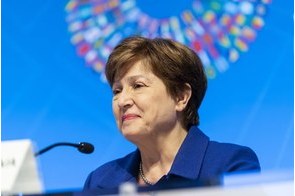International DFIs announce $400 billion to achieve Sustainable Development Goals

Summary
MDB development finance has grown from $50 billion in 2001 to $127 billion in 2015.
The multilateral development banks (MDBs) and IMF have indicated their plans to extend more than $400 billion in financing over the next three years as they work more closely with private and public sector partners to help mobilize the resources needed to meet the huge challenge of achieving the Sustainable Development Goals (SDGs).
The MDBs – comprising the African Development Bank, Asian Development Bank, European Bank for Reconstruction and Development, European Investment Bank, Inter-American Development Bank, World Bank Group – and the International Monetary Fund announced their plans today, a few days before the 3rd International Conference on Financing for Development scheduled to hold in Addis Ababa, from July 13-16.
Official Development Assistance (ODA), estimated at $135 billion a year, provides a fundamental source of financing, especially in the poorest and most fragile countries. However, this is insufficient to meet the ambitious demands of the SDGs.
Jim Yong Kim, President, World Bank Group, stated that, “We must cast away the stereotypes of aid and think about development differently. It’s about creating opportunity for all, giving people an equal chance to succeed in life, and preparing the world to deal with the challenges of climate change and the next pandemic.”
Investment needs in infrastructure alone reach up to $1.5 trillion a year in emerging and developing countries. Meeting the staggering but achievable needs of the SDG agenda requires everyone to make the best use of each dollar from every source, and draw in and increase public and private investment.
“We need trillions, not billions, of dollars to accomplish these goals, and the money will come from many sources: developing countries, private sector investment, donors, and international financial institutions. By working together, we can help people build better lives with good education, quality health care, clean water, and proper sanitation. Those investments in people will help end extreme poverty in just 15 years,” the President of the World Bank Group said.
MDB development finance has grown from $50 billion in 2001 to $127 billion in 2015. For each dollar invested by its shareholders, MDBs are able to commit $2-5 in new financing each year. The MDBs’ own direct private sector investments have increased fourfold over this period. They mobilize an additional $2-5 in private investment for every dollar they invest directly in private sector operations. The vow to increase their contribution to more than $400 billion over the next three years reflects in part efforts to make even better use of their balance sheets.
The MDBs and the IMF are partnering with countries to leverage more resources include the development of new approaches and tools to help developing countries play a stronger role in harnessing national resources.
Christine Lagarde, Managing Director, IMF, said, “This year marks a once-in-a-generation opportunity for global development. The only way to seize it is through partnership. To go far, we must go together. The IMF – with its global membership and mandate to promote economic growth and stability – is a committed partner.”
For example, the IMF has introduced a new toolkit to assess and improve tax policies and expand instruments such as e-procurement to achieve better government spending. But increasing external resource flows to developing countries for investment is essential to achieving the SDGs—but these flows can be expected to materialize only in circumstances where countries have coherent development strategies consistent with maintaining macroeconomic stability while also ensuring the delivery of key public sector services and a business environment supportive of growth.
“2015 is a critical year in charting the development future of Africa – the continent that still has the greatest development needs, and the continent that presents the greatest opportunity – for itself and for the world,” President of the AfDB, Donald Kaberuka, who steps down in September, stated.
The private sector is also playing an increasing role in financing goods, services and infrastructure. The MDBs are committed to engaging differently with private sector partners on a wide range of interventions, including connecting investors with opportunities, helping countries make investments more attractive, and building local financial markets.
The MDBs are also partnering with others to develop innovative financing approaches to support global needs, such as health and climate, building on extensive work already underway.
Related
-
AfDB’s new 5-year strategy for Nigeria to tackle Covid-19 economic shocks
The 2020-2024 CSP has two key priority areas for Nigeria, namely infrastructure development and social inclusion through ...
-
IMF grants debt relief for 19 African countries
The purpose of debt relief under the CCRT is to free up resources assigned to debt service to meet exceptional balance of ...
-
EIB pledges €170 million for starting National Development Bank of Ghana
The EIB last year provided EUR 5 billion for public and private investment across Africa.








